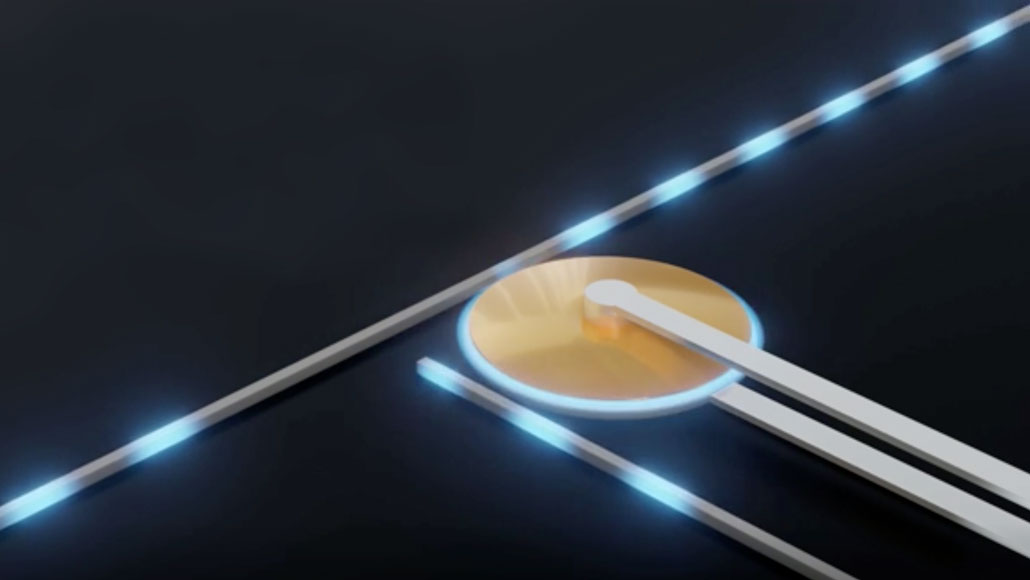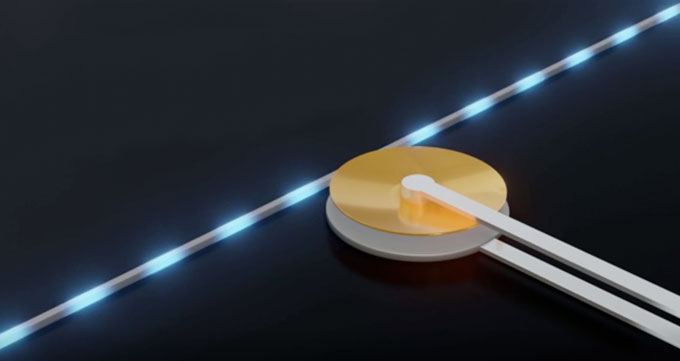A tiny switch could redirect light between computer chips in mere nanoseconds
Light waves can transport information more efficiently than electric current

A new kind of tiny switch uses an ultrathin gold disk to catch light waves (blue pulses) traveling down one wirelike structure called a waveguide (flowing top right to bottom left), and transfers that light to a new waveguide. Many of these switches connected in an array could help a computer process information using light, rather than electric current.
S. Kelley/NIST
- More than 2 years ago
Microscopic switches that route light signals between computer chips like tiny traffic conductors could help make faster, more efficient electronics.
Light waves can carry information more easily than the electric current used in traditional circuitry, because particles of light called photons zip through materials without interacting with their surroundings as much as electrons. But so far, mechanical switches designed to manipulate such data-carrying light waves have run relatively slowly and required impractically high electric voltages to work.
Now, newly designed switches redirect light in less than a millionth of a second using just about one volt of electricity — comparable to the voltages used in ordinary electronics, researchers report in the Nov. 15 Science. Electronics outfitted with the new switch design to process data with light rather than electricity could help self-driving cars scan their surroundings for traffic and pedestrians or read out information from quantum computers.
Each switch comprises an ultrathin gold disk suspended above a silicon plate. Applying a small voltage across the switch forces the gold disk to bend upward like a bowl, or bow downward like an umbrella. The gold disk’s orientation at any given time controls whether light flowing through a nearby wirelike structure called a waveguide continues uninterrupted or gets rerouted.
As light in the waveguide passes by the switch, some light leaks into a racetrack-shaped gap between the gold disk and the silicon plate, whips around the track and recombines with light in the waveguide. If the gold plate is curved upward, the peaks and valleys of light waves that exit the track align with those in the waveguide — reinforcing the light along its original path.
But if the gold plate is bent down toward the silicon plate, interactions with electrons in the gold delay light as it travels around the racetrack. That causes the valleys of light waves exiting the track to coincide with the peaks of waves flowing through the waveguide, canceling each other out and blocking the flow of light along its original course.

A second waveguide placed on another side of the silicon plate can provide an exit ramp for some light to escape the racetrack and start down a new path. Many interconnected switches choreographing the travel of various light signals between different electronic components could help a computer perform sophisticated operations.
The new switches redirect light waves in tens of nanoseconds, compared with the microseconds-long switching times of similar devices. Such high speeds are possible because the gold plate is more lightweight and easy to manipulate than the bulky components in other switches, says study coauthor Christian Haffner, a nanophotonics researcher at ETH Zurich and the National Institute of Standards and Technology in Gaithersburg, Md. “It’s like [driving] a sports car compared with a truck.”
Leonardo Midolo, a physicist at the University of Copenhagen not involved in the work, is impressed with the new design, which requires only 1.4 volts of electricity to flip a 10-square-micrometer switch. Other designs would require around 10 volts. “It shows the potential for this particular class of devices” to enter real-world use, he says.
But researchers should try to refine the current prototype to better preserve light signals when switching waves to a new waveguide, Midolo says. Currently, a light beam retains only about 60 percent of its original strength when it takes a detour. If each switch washes out almost 40 percent of the original light wave, it only takes a few switches for that information to be almost completely unreadable, he says. “This is definitely something that could be improved.”





